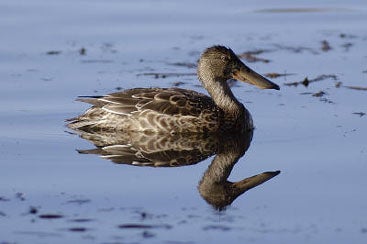SCIENTIFIC NAME:
Anas clypeata
OTHER NAMES:
Spoonbill, Spoonie, Smiley
STATUS:
Historical breeder. Common in winter, spring, and fall in all regions, and occasional in summer in Tennessee Valley region. Lowest Conservation Concern.
DESCRIPTION:
A medium-size dabbling duck with a length of 18 to 20 inches and weighing 1.1 to 1.8 lbs. Both male and female have a large spoon like bill that widens toward the tip. The bill on the male is black and the female has an olive-green with orange that is speckled with black dots. The male has an iridescent green head and neck with a white chest and breast. The belly and sides are chestnut in color. A white stripe extends from the breast along the margin of the gray-brown back with white spots on the flank. The wings have a gray-blue shoulder patch that is separated with a green speculum that is bordered with a white stripe. The female has a light brownish head with a blackish crown and the body is a brownish color with speckles. The upper wing coverts are grayish-blue, the greater secondary coverts are tipped with white and the secondaries are brown with a slight greenish sheen.
DISTRIBUTION:
The northern shoveler is one of the most common and cosmopolitan of ducks, occurring extensively in both the northern and southern hemispheres. Like most waterfowl, it migrates each fall from the prairie pothole region of the United States and Canada to wintering grounds in coastal Louisiana, Texas and Mexico.
HABITAT:
In the breeding season, northern shovelers prefer short grassy, non-woody areas that are 75 to 200 feet from water. In areas where grass cover is limited, they will utilize hayfields, meadows, and marshes of bulrushes that may be up to one mile away from the nearest water source. During the winter months, northern shovelers can be found on lakes, ponds and marshes that are rich in aquatic vegetation and insects.
FEEDING HABITS:
Northern shovelers feed by dabbling and sifting for seeds of bulrushes, saw grass, smartweed, sedges, duckweeds and pondweeds in shallow water. Their spoon like bill is used as a filtering system to skim the water for aquatic insects, mollusks and crustaceans that are taken in at the bill tip and jetted out at the base.
LIFE HISTORY AND ECOLOGY:
Pair bonding begins during the winter months but as spring approaches the hen may be courted by several males before breeding. Nesting will begin between April and June. The female will spend 6 to 8 days selecting and constructing a nest site in a shallow depression on the ground that is lined with grass and down feathers. The female will lay a clutch of 5 to 14 eggs (average is 9) that she will incubate for about 28 days. When the eggs hatch the female will lead her brood to the nearest pond.
Northern shoveler populations, like most waterfowl, fluctuate year by year depending on available nesting and brooding habitat in the prairie pothole regions of the United States and Canada. During the fall and winter months, the northern shoveler can be seen on many of Alabama’s waterways.
REFERENCES:
Ducks, Geese and Swans of North America; Frank C. bellrose
Ducks Unlimited - www.ducks.org
Delta Waterfowl- www.deltawaterfowl.org
Author:
Phil Miller, Wildlife Biologist, Division of Wildlife & Freshwater Fisheries






